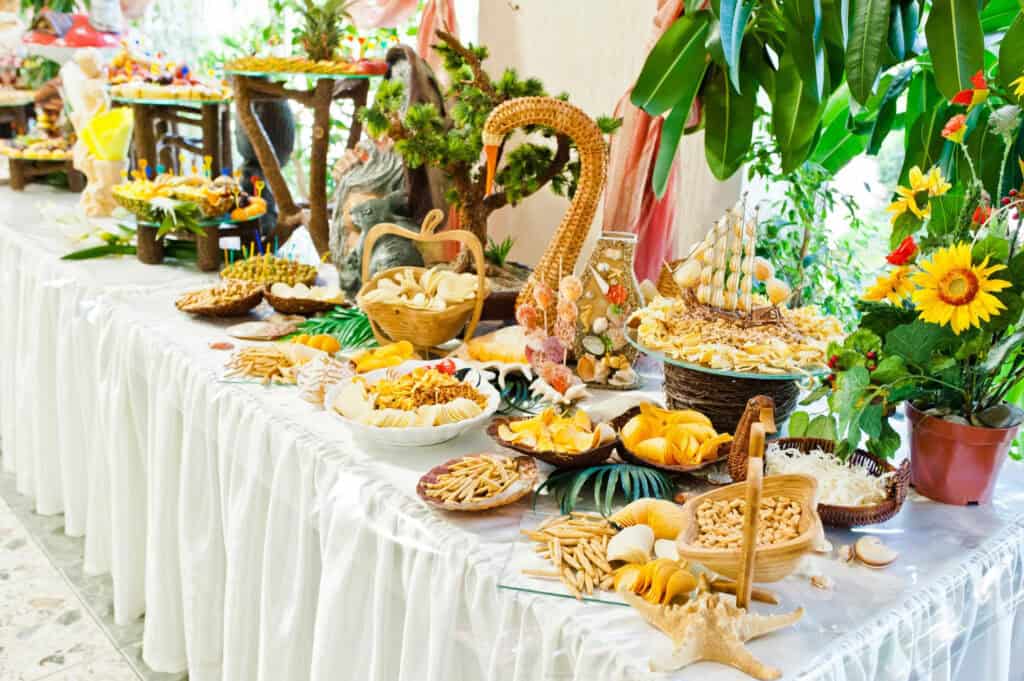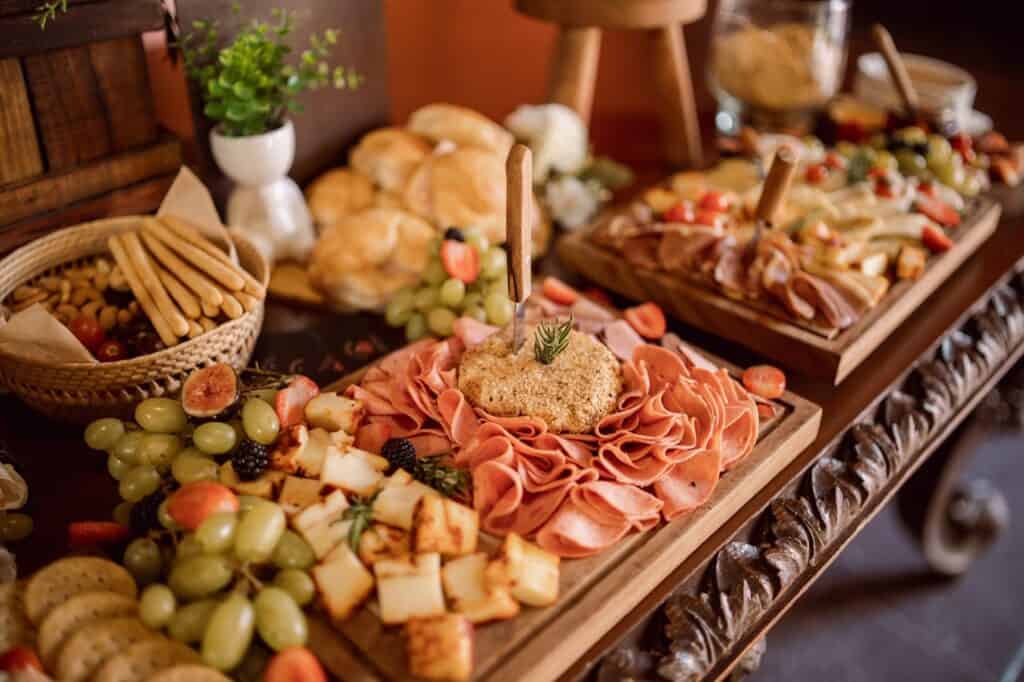
By Jermaine Thomas January 28, 2025
Imagine a dining experience that doesn’t just satisfy your taste buds but also engages your other senses. Multisensory catering has redefined how people experience food, transforming events into unforgettable journeys through taste, sound, sight, smell, and touch. By blending creative presentation and sensory elements, this immersive approach captivates guests in ways traditional catering cannot.
What Is Sensory Catering?
Sensory catering is more than just serving delicious dishes; it’s about creating an experience where every sense is activated. The idea revolves around connecting flavors, textures, aromas, sounds, and visuals to heighten the overall impact of dining.
For instance, imagine enjoying a dessert that’s not only beautifully plated but accompanied by a subtle soundtrack of flowing water and served on a plate that smells faintly of vanilla. These additional elements evoke emotions and memories, enhancing the enjoyment of the meal. Sensory catering allows event planners to go beyond the basic culinary offerings and craft an experience that stays etched in guests’ minds.
In today’s events industry, where people seek experiences over material goods, multisensory dining has gained popularity. From weddings and corporate galas to themed parties, sensory catering is being used to deliver highly memorable events. It’s particularly appealing in the American market, where creating standout moments can make or break an occasion.
Why Multisensory Catering Matters
Events are no longer just about gathering people together; they are about creating meaningful experiences. Multisensory catering helps achieve this by making food a central focus of interaction and enjoyment.
Taste may be the cornerstone of dining, but when it’s combined with other sensory elements, it becomes part of a larger narrative. For example, pairing a smoky barbecue dish with warm, earthy music and the aroma of charred wood can evoke the feeling of sitting around a campfire. This storytelling aspect makes multisensory dining a powerful tool for event hosts.
There’s also a scientific side to this. Research has shown that our senses work together to shape perception. A dish that’s visually appealing or paired with a complementary scent often tastes better to the diner. By tapping into these sensory connections, event planners can significantly elevate the overall dining experience.
Additionally, sensory catering is a fantastic way to foster engagement. When attendees are immersed in a multisensory environment, they’re more likely to connect emotionally with the event’s theme and purpose. This makes it ideal for everything from product launches to milestone celebrations.

Elements of Multisensory Dining
Sight
Presentation is often the first impression guests have of a dish. With multisensory catering, visual appeal takes center stage. Chefs and event designers use vibrant colors, intricate plating techniques, and creative lighting to wow guests before they even take a bite.
For instance, a salad served in a glass sphere with fog swirling around it creates a dramatic moment. Similarly, desserts that look like works of art can leave attendees snapping photos and talking about them long after the event.
Visuals also play a role in setting the mood. The use of projections, themed decor, and ambient lighting can reinforce the culinary theme. For example, a beach-inspired event might use blue lighting, sand-like table textures, and seashell-shaped dishes to transport guests to a seaside paradise.
Sound
Sound often goes unnoticed in dining experiences, but it’s an essential component of multisensory catering. The right sounds can enhance the atmosphere and complement the flavors being served.
For example, soft classical music might pair beautifully with a sophisticated five-course meal, while upbeat tunes can energize a casual cocktail party. Some caterers even create soundscapes specific to individual dishes. Imagine sipping a seafood bisque while listening to ocean waves or enjoying a crunchy snack paired with crisp, snapping sounds.
This element is particularly impactful in creating thematic dining experiences. Sound helps tie the event’s concept together and keeps guests fully immersed in the setting.
Smell
Aroma has a powerful connection to memory and emotion. It’s no surprise that smell is a key component of sensory catering. The right scents can enhance a dish’s flavor profile and set the tone for an event.
For instance, piping hot bread served with the smell of fresh herbs wafting through the air can evoke feelings of warmth and comfort. Similarly, adding fragrant oils or floral accents to a dining area can create a luxurious ambiance.
Some events use diffusers or scented candles strategically to complement the menu. These subtle yet impactful touches can create a more cohesive sensory experience, making the meal unforgettable.
Touch
Texture is a fundamental aspect of how people experience food, and multisensory catering embraces this fully. From the crunch of a perfectly fried appetizer to the silky smoothness of a mousse, texture adds another layer of enjoyment.
But touch isn’t limited to food. It extends to the environment. The texture of table linens, the weight of utensils, and even the feel of serving dishes contribute to the overall experience. For example, using wooden plates at a rustic event or marble trays at a high-end gala can subtly reinforce the theme.
Interactivity also plays a role here. Food stations where guests can assemble their own tacos or desserts give them the opportunity to physically engage with their meal, adding an extra element of fun.
Taste
Taste remains at the heart of any dining experience. Multisensory catering ensures that the flavors themselves are bold, harmonious, and reflective of the event’s theme.
Chefs often experiment with unexpected combinations to surprise and delight guests. Sweet and savory pairings, unusual spices, and fusion cuisine can all take center stage in multisensory menus. Offering a mix of familiar and adventurous options caters to diverse palates while keeping things exciting.
When taste is combined with the other sensory elements, it becomes part of a larger symphony. Guests leave the event not only satisfied but also with a newfound appreciation for how flavors and senses interact.
How Event Planners Use Multisensory Catering
Event planners in the United States are increasingly embracing multisensory catering to set their events apart. The approach is especially popular at high-end gatherings, such as weddings, corporate events, and exclusive parties.
Planners often work closely with chefs, designers, and audiovisual experts to bring these experiences to life. For example, a tropical-themed wedding might feature dishes served on banana leaves, cocktails with edible flowers, and a steel drum band to complete the island vibe.
Corporate events also benefit from sensory catering. A tech company’s product launch might include futuristic lighting, minimalist decor, and a menu featuring molecular gastronomy techniques. These details create a cohesive experience that reinforces the event’s purpose and brand identity.
Even smaller, intimate gatherings can incorporate sensory elements. From a backyard barbecue with smoky aromas and rustic decor to a children’s party with colorful food and playful music, the possibilities are endless.
The Growing Demand for Immersive Food Experiences
As American consumers increasingly value experiences over possessions, the demand for immersive food experiences continues to grow. Social media plays a significant role in this trend. Events that offer Instagram-worthy moments, such as dramatic food presentations or themed decor, attract significant attention and become talking points.
This shift has also influenced catering companies, which now offer services specifically geared toward creating sensory-rich events. From pop-up dining experiences to interactive tasting stations, these offerings cater to modern preferences for personalization and engagement.
Moreover, the rise of sustainable and locally sourced ingredients has added another layer to sensory catering. Guests appreciate knowing that their food is fresh and ethically sourced, making the experience even more meaningful.

Challenges in Executing Multisensory Catering
While multisensory catering offers many benefits, it also comes with challenges. Coordinating multiple sensory elements requires careful planning and collaboration among various professionals. A misstep in one area—such as overpowering scents or mismatched visuals—can detract from the overall experience.
Budget constraints can also be a factor. Creating a multisensory dining experience often involves additional costs for decor, technology, and specialized staff. However, creative solutions, like DIY elements or selective sensory enhancements, can make it accessible to a wider range of events.
Finally, catering to diverse sensory preferences can be tricky. What might delight one guest could overwhelm another. This is where thoughtful planning and flexibility come into play, allowing for adjustments that suit the majority.
Tips for Planning a Sensory Catering Experience
Start with a Theme: A clear theme helps guide all sensory elements. Whether it’s a garden party or a futuristic dinner, the theme should inform the menu, decor, and overall vibe.
Collaborate with Experts: Work with chefs, event designers, and audiovisual professionals to ensure a cohesive experience. Their expertise can help bring your vision to life.
Test the Elements: Before the event, test all sensory components together to ensure they complement each other. This minimizes the risk of clashes and ensures a harmonious experience.
Consider the Guests: Keep your audience in mind when planning sensory elements. Strive for a balance that appeals to a wide range of tastes and preferences.
Embrace Innovation: Don’t be afraid to experiment with new ideas, like edible art, virtual reality dining, or sound-activated food presentations. These unique touches can elevate your event.
Conclusion
Multisensory catering transforms events into unforgettable experiences by engaging all five senses. By combining flavors, textures, visuals, aromas, and sounds, it creates a feast for the senses that leaves a lasting impression on guests. As the demand for immersive food experiences grows, event planners and caterers are finding innovative ways to bring this concept to life. Whether it’s a lavish wedding, a corporate gala, or an intimate gathering, sensory catering offers endless possibilities to create truly memorable moments.